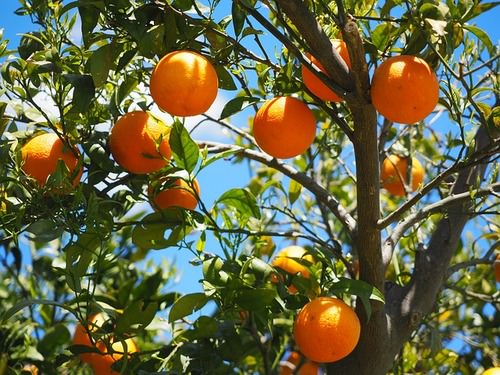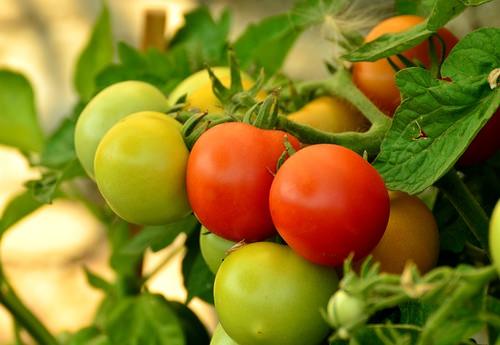13.61 乙烯和Brassonos类固醇 -- -- 高级
章节大纲
-
Plant Hormones: Ethylene and Brassonosteroids
::植物激素:乙烯和Brassonos类固醇Ethylene: Ripening Fruit and Falling Leaves
::乙烯:开花果和落叶Ancient Africans practiced gashing of figs in order to ripen them. We now know that wounding fruits causes them to produce more of the ethylene , which has as one of its effects the ripening of fruit ( Figure ). Ethylene is a gas whose concentration depends on rates of synthesis and . In fruits, ethylene causes breakdown of cell walls to soften the fruit, conversion of starch into sugar to sweeten it, and loss of chlorophyll to reveal other colors which signal “ripe” to for dispersal . The presence of ethylene stimulates the synthesis of more ethylene – accelerating ripening in a positive feedback loop. Finally, ethylene promotes abscission , which breaks the connection between the plant and the fruit’s , so that the fruit falls to the ground.
::古代非洲人为了熟化这些无花果,对无花果进行了石刻。 我们现在知道,果实的损伤导致它们生产更多的乙烯,其效果之一是水果的成熟(Figure ) 。 乙烷是一种气体,其浓度取决于合成率和浓度。 在水果中,乙烯导致细胞墙破裂以软化果实,将淀粉转化为糖来加糖,并导致叶绿素的流失以揭示其他颜色,这些颜色标志着“足迹 ” 撒布。 乙烷的存在刺激了更多乙烯的合成 — — 在积极的反馈循环中加速成熟。 最后,乙烯促进了消除,打破了植物和水果之间的联系,使果实落地。Ancient Africans slashed figs in order to ripen them. We now know that wounded fruits produce more ethylene, a hormone which promotes ripening. In addition to ripening fruit, ethylene speeds aging and dropping of deciduous leaves. A decline in allows the ethylene to accomplish these tasks. Before leaf fall, stems reabsorb valuable chemicals from leaves, storing them for release into new leaves the following spring. Breakdown of chlorophyll is part of this “salvage”, revealing yellow and orange carotenoids, which had been hidden behind the intense green. An abscission layer near the base of the petiole develops a weakened layer of with thinning walls and a protective layer of cork adjacent to the stem, which will become the leaf scar. Eventually, the thin-walled layer separates and the leaf falls. By preparing for a prolonged period in which cannot absorb (due to frost or drought), leaf abscission conserves nutrients and energy in seasonal climates.
::除了成熟的果实外,乙烯速度还在老化和低落的叶叶落落。 乙烯的衰落使得乙烯能够完成这些任务。 在叶叶落之前,从叶叶中分解宝贵的化学品,将其储存起来,以释放到下一春的新叶。 叶绿素的分解是这一“盐水”的一部分,它揭示了隐藏在密集绿地后面的黄色和橙色的木质。 花瓣底部的废气层形成一层薄壁和紧靠干叶叶的软骨的保护层,它们将成为叶疤。 最终,薄墙层分离和叶叶落落。 通过准备一个无法吸收(由于霜冻或干旱)的很长的时期,叶叶叶可以保护季节性气候的营养和能量。-
Edit here for caption
::编辑此标题 -
Edit here for caption
::编辑此标题
Two major functions of the hormone ethylene are fruit ripening (left) and leaf loss (right). These processes share the breakdown of chlorophyll; in fruits, the yellows and oranges revealed advertise their ripeness to animals for dispersal. Another shared feature is abscission; weakened layers of cells – and a protective layer next to the stem – allow many fruits and most leaves to fall to the ground for dispersal and recycling. Ethylene presents challenges for fruit production and distribution. Perhaps you have heard the expression “One rotten apple can ruin the whole basket.” Now you know that ethylene produced by that rotten apple is the culprit for this all-too-true expression. Bananas, especially, produce abundant ethylene, so they are usually picked green and then treated with ethylene after arrival to ripen for customers. Genetic engineering has attempted to control this process even more tightly in tomatoes, which ship much more successfully when they are green ( Figure ). Two types of genetic modifications have been attempted: one which altogether destroys the activity of an involved in ethylene synthesis (you can always add ethylene when the time is right for ripening), and another which renders ethylene receptors dysfunctional. The latter suggests that ripening would be impossible – and some engineered fruits seem to support this conclusion!
::乙烯对水果的生产和分配提出了挑战。也许你听到过“一个腐烂的苹果可以毁掉整个篮子 ” 。 现在你知道,由这个腐烂的苹果生产的乙烯是这一完全真实的表达方式的罪魁祸首。 特别是香蕉生产大量的乙烯,因此它们通常被采摘为绿色,然后在进入成熟期后对顾客进行乙烯处理。 遗传工程试图在西红柿中更严格地控制这一进程,西红柿在绿色时更成功地运输了它。 已经尝试了两种基因改变:一种完全摧毁了与乙烯合成有关的人的活动(在成熟期到来的时候,你总是可以添加乙烯),另一种使乙烯受体功能失调。 后者表明成熟是不可能的 — — 一些经过改造的水果似乎支持这一结论。Genetic engineering has produced tomatoes which allow us to delay ripening until after shipping; green tomatoes are firm and less subject to damage than ripened fruit. One mutation knocks out an enzyme required to synthesize ethylene, so ethylene is added after shipping to ripen fruit. Another mutation inactivates an ethylene receptor; it is difficult to imagine how such a fruit could ever be ripened. Brassinosteroids: Stimulate Plant Cell Elongation
::Brascinosterods: 刺激植物细胞延长Brassinosteroids are a group of steroidal that promote stem elongation and cell divisions. Brassinosteroids have been shown to be involved in a number of plant processes:
::Brasinosteroids是一组促进干延长和细胞分解的血清杀菌剂。-
Promotion of cell expansion and cell elongation
::促进扩大细胞和延长细胞长度 -
and cell wall
regeneration
::和单元格墙再生 -
Promotes vascular
differentiation
through a signal
transduction
mechanism
::通过信号传送机制促进血管区分 -
Necessary for
pollen tube
formation
::花粉管形成的必要 -
Provides some protection during cold periods as well as during drought.
::在寒冷时期和干旱期间提供一些保护。
Plant Hormone Overview
::植物激素概览The following table summarizes this chapter’s information on plant hormones.
::下表概述了本章有关植物激素的资料。Plant Hormones and their Effects Hormone Type or Group Target Tissue Effect(s) Adaptive Value (ABA) Bud Inhibits to produce dormancy Optimal timing of growth - Seed Inhibits germination , producing dormancy Optimal timing of germination - Stomata (Guard Cells)
::Stomata( 保护单元格)Closes stomata when roots sense drought Conserves moisture Auxins (IAA, IBA)
::Auxins (IAA, IBA)Roots With cytokinins, cell division Growth - Stems Phototropism Growth toward light - Woody Stems Stimulate growth of cambium Secondary growth - Buds Promote apical dominance Growth in height, diameter - Fruit Promotes ripening by stimulating ethylene production Attract frugivores to disperse seeds Cytokinins Shoots, buds With auxins, cell division Growth - Buds Inhibit apical dominance Promote lateral buds, bushiness - Flowers Slow aging process Extend pollination , Gibberellins G 1 - G 110
::吉韦列林斯G1-G110Seed: Endosperm Breakdown of stored food to basic nutrients Provide nutrients for embryo growth, seed germination - Leaves and stems Elongation: “bolting” Elevate flowers for pollination, and seeds for dispersal Ethylene Fruit: cell walls Breakdown to soften flesh Attract frugivores to disperse seeds - Fruit: starch Breakdown to sugar for sweetening Attract frugivores to disperse seeds - Fruit and leaves Breaks down chlorophyll, revealing other pigment colors; in fruits, signals “ripe” Conserve nutrients; Attract frugivores to disperse seeds - Leaves, stems Reabsorbs nutrients into stems to prepare for dormancy Conserve nutrients -
Abscission layer (stems of fruits and leaves) Weakens cell walls and tissues so leaves and fruits fall to ground Conserve moisture, energy during seasonal dormancy Summary
::摘要-
Ethylene ripens fruits by breaking down cell walls, starches, and chlorophyll.
::乙烯通过破碎细胞墙、恒星和叶绿素 来撕裂水果 -
As auxins drop, ethylene directs chlorophyll breakdown, nutrient reabsorption, and abscission of leaves.
::苯乙烯随着助因下降,导致叶绿素分解、养分再吸附和树叶除去。 -
Genetically modified tomatoes mutate genes for ethylene production or ethylene receptors.
::用于乙烯生产或乙烯受体的经基因修改的西红柿变异基因。
-




